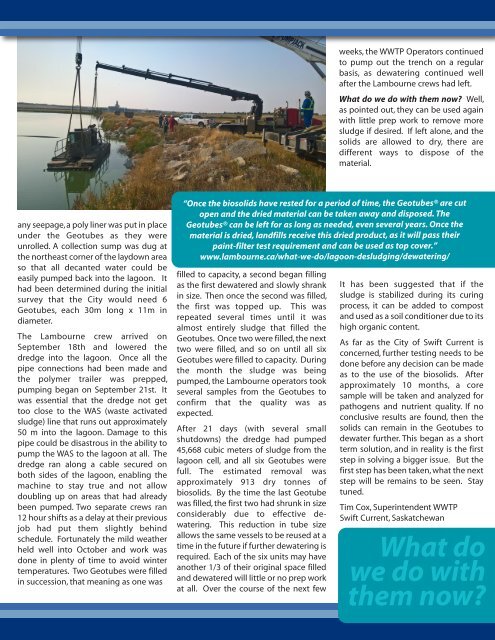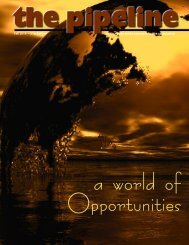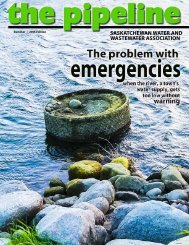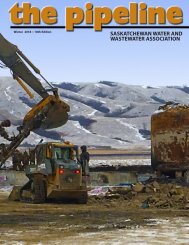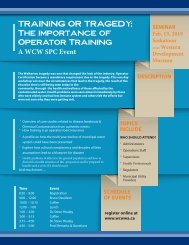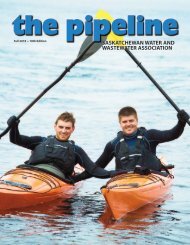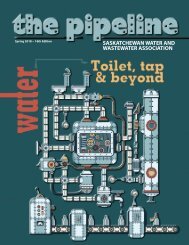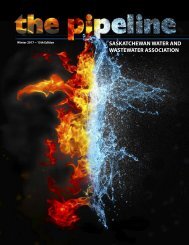June 2018 Pipeline
You also want an ePaper? Increase the reach of your titles
YUMPU automatically turns print PDFs into web optimized ePapers that Google loves.
weeks, the WWTP Operators continued<br />
to pump out the trench on a regular<br />
basis, as dewatering continued well<br />
after the Lambourne crews had left.<br />
What do we do with them now? Well,<br />
as pointed out, they can be used again<br />
with little prep work to remove more<br />
sludge if desired. If left alone, and the<br />
solids are allowed to dry, there are<br />
different ways to dispose of the<br />
material.<br />
any seepage, a poly liner was put in place<br />
under the Geotubes as they were<br />
unrolled. A collection sump was dug at<br />
the northeast corner of the laydown area<br />
so that all decanted water could be<br />
easily pumped back into the lagoon. It<br />
had been determined during the initial<br />
survey that the City would need 6<br />
Geotubes, each 30m long x 11m in<br />
diameter.<br />
The Lambourne crew arrived on<br />
September 18th and lowered the<br />
dredge into the lagoon. Once all the<br />
pipe connections had been made and<br />
the polymer trailer was prepped,<br />
pumping began on September 21st. It<br />
was essential that the dredge not get<br />
too close to the WAS (waste activated<br />
sludge) line that runs out approximately<br />
50 m into the lagoon. Damage to this<br />
pipe could be disastrous in the ability to<br />
pump the WAS to the lagoon at all. The<br />
dredge ran along a cable secured on<br />
both sides of the lagoon, enabling the<br />
machine to stay true and not allow<br />
doubling up on areas that had already<br />
been pumped. Two separate crews ran<br />
12 hour shifts as a delay at their previous<br />
job had put them slightly behind<br />
schedule. Fortunately the mild weather<br />
held well into October and work was<br />
done in plenty of time to avoid winter<br />
temperatures. Two Geotubes were filled<br />
in succession, that meaning as one was<br />
“Once the biosolids have rested for a period of time, the Geotubes® are cut<br />
open and the dried material can be taken away and disposed. The<br />
Geotubes® can be left for as long as needed, even several years. Once the<br />
material is dried, landfills receive this dried product, as it will pass their<br />
paint-filter test requirement and can be used as top cover.”<br />
www.lambourne.ca/what-we-do/lagoon-desludging/dewatering/<br />
filled to capacity, a second began filling<br />
as the first dewatered and slowly shrank<br />
in size. Then once the second was filled,<br />
the first was topped up. This was<br />
repeated several times until it was<br />
almost entirely sludge that filled the<br />
Geotubes. Once two were filled, the next<br />
two were filled, and so on until all six<br />
Geotubes were filled to capacity. During<br />
the month the sludge was being<br />
pumped, the Lambourne operators took<br />
several samples from the Geotubes to<br />
confirm that the quality was as<br />
expected.<br />
After 21 days (with several small<br />
shutdowns) the dredge had pumped<br />
45,668 cubic meters of sludge from the<br />
lagoon cell, and all six Geotubes were<br />
full. The estimated removal was<br />
approximately 913 dry tonnes of<br />
biosolids. By the time the last Geotube<br />
was filled, the first two had shrunk in size<br />
considerably due to effective dewatering.<br />
This reduction in tube size<br />
allows the same vessels to be reused at a<br />
time in the future if further dewatering is<br />
required. Each of the six units may have<br />
another 1/3 of their original space filled<br />
and dewatered will little or no prep work<br />
at all. Over the course of the next few<br />
It has been suggested that if the<br />
sludge is stabilized during its curing<br />
process, it can be added to compost<br />
and used as a soil conditioner due to its<br />
high organic content.<br />
As far as the City of Swift Current is<br />
concerned, further testing needs to be<br />
done before any decision can be made<br />
as to the use of the biosolids. After<br />
approximately 10 months, a core<br />
sample will be taken and analyzed for<br />
pathogens and nutrient quality. If no<br />
conclusive results are found, then the<br />
solids can remain in the Geotubes to<br />
dewater further. This began as a short<br />
term solution, and in reality is the first<br />
step in solving a bigger issue. But the<br />
first step has been taken, what the next<br />
step will be remains to be seen. Stay<br />
tuned.<br />
Tim Cox, Superintendent WWTP<br />
Swift Current, Saskatchewan<br />
What do<br />
we do with<br />
them now?


